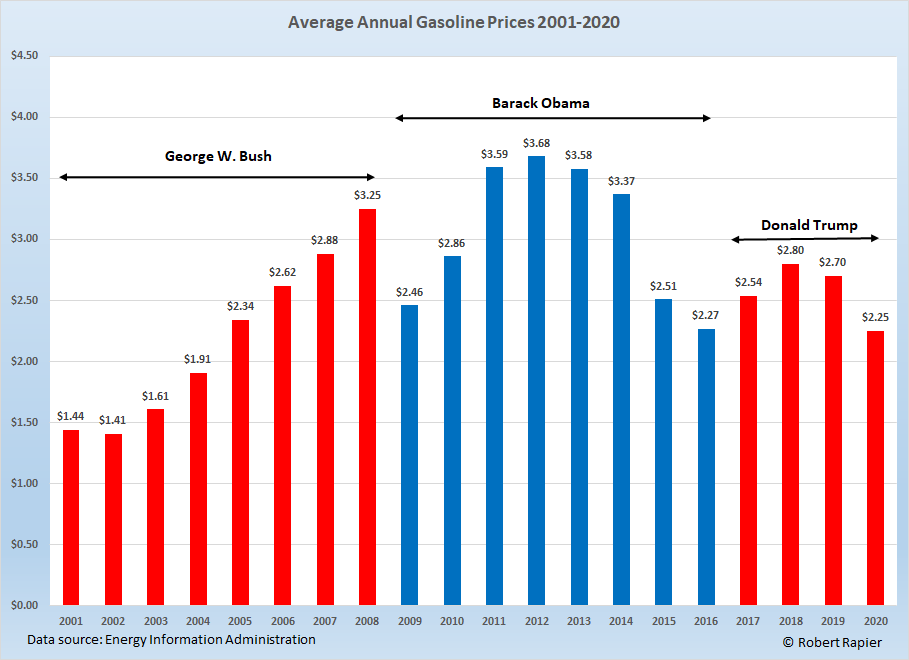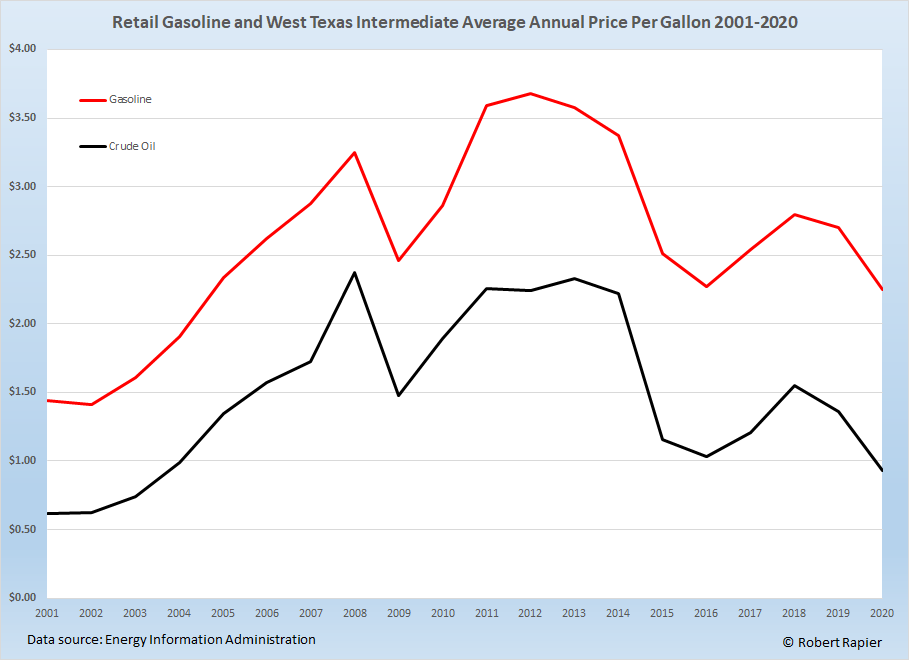Last week I filled up with gasoline, and the price was over $3.00 a gallon. It’s been a long time since I paid that much for gasoline. In fact, I checked the data at the Energy Information Administration (EIA) to see the last time weekly gasoline prices were above $3.00/gal. It was in May 2018, during President Trump’s second year in office.
In the previous two articles, I addressed some beliefs relating to presidents and gasoline prices. One of the strongest current beliefs is that President Trump came into office and took decisive actions that drove down gasoline prices. President Biden, the belief goes, has now taken actions that have driven up gasoline prices.
This topic was covered in the previous articles (here and here), but today I want to address the data. Where were gasoline prices during the presidencies of the last three men to hold office? I will also provide commentary on major factors that influenced those prices.
The following graphic shows the average annual gasoline price during each year of the last three presidential terms. The numbers come from the EIA, and they represent the average retail price of all grades of gasoline. You can see the raw data here. I charted each year in 52-week increments starting with each president’s inauguration.

You can interpret this data in many different ways, but let’s first discuss the overall evolution of gasoline prices over this period. Then I will address the causes.
The Evolution of Gasoline Prices
During the first two years of his first term, President Bush oversaw low and relatively stable gasoline prices. But prices were higher in his third year in office, and they continued to rise through his eighth year in office. Between his first and seventh year, the average annual price of gasoline doubled. No other president in modern history has overseen such a huge percentage rise in the price of gasoline.
Something dramatic changed during President Obama’s first year in office. The price of gasoline plunged. If you are a fan of President Obama, you might give him credit for this drop in prices. But, as I will explain later, it’s not that simple.
Like Bush, Obama initially experienced rising gasoline prices. Those prices reached a peak at the highest annual average of any president, before falling back down to the lowest level since Bush’s first term. The reasons for this are clearly understood, as I will explain below.
Gasoline prices rose during each of President Trump’s first two years in office, reversing the two-year trend that ended Obama’s second term. By Trump’s third year in office, prices fell slightly, but then they fell sharply during his fourth year to a level almost the same as during Obama’s eighth year.
The Reasons for the Changes
I would argue that none of the major changes in the graph above have much of anything to do with presidential actions. I am going to explain the reasons for what actually happened during this period, but first let’s look at another chart. The following graphic shows the average annual price of retail gasoline — same as the previous chart — but this time plotted against the average annual price of West Texas Intermediate (WTI) crude oil.

This graphic shows the intricate linkage between crude oil and gasoline prices. They rise and fall together with a high correlation. And while it may be more difficult to pin down what exactly causes gasolines prices to move, it’s not that difficult to pin down what caused oil prices to make major moves during this period.
Couldn’t one argue that presidential policies impact oil prices, and therefore gasoline prices? Over the long term, yes. But the macro factors impacting oil prices are far greater than the impacts from the decisions a president makes.
In the short term, a president can try to move markets, but those impacts are fleeting. If a president announces a release of oil from the Strategic Petroleum Reserve — which they often do prior to elections — then that can cause a brief dip in the price of oil, and subsequently gasoline. But it doesn’t have a sustained impact on prices.
Here’s what actually happened over the past 20 years. President Bush took over during the early 2000s recession, which was caused in part by the dot-com bust. He then encountered the 9/11 tragedy early during his first term, and that helped keep a chill on the global economy. That is largely responsible for keeping oil prices in check during his first term.
During President Bush’s two terms, U.S. oil production fell steadily. Imports of crude oil and finished products had been rising for years, but they reached an all-time-high in the U.S. during Bush’s second term. OPEC was gaining increasing pricing power, and they were slow to respond to the ongoing decline of U.S. oil production. That led to oil prices that continued to spiral higher. WTI reached a peak price above $140 a barrel (bbl) in June and July 2008.
That spike in prices helped push the U.S. into a recession, which caused oil prices to come crashing down to $30/bbl by the end of 2008. President Obama took over during this recession in early 2009, and hence he received the benefit of low gasoline prices during his first year in office. But the econ0my recovered, and the price of WTI soon returned back above $100/bbl.
Meanwhile, a hydraulic fracturing (“fracking”) boom had been gaining momentum since Bush’s second term in office. By 2014 U.S. oil production had increased by so much that OPEC responded with a price war that ultimately sent oil prices below $30/bbl. That’s why gasoline prices plunged during Obama’s last two years in office.
By the time President Trump assumed office, OPEC had learned their lesson, and was back to trying to curb production to influence prices. But the continued rise of U.S. oil production made this difficult. While they were able to boost prices somewhat, the power they had to boost prices a decade earlier had diminished.
Then the Covid-19 pandemic hit in 2020, and that helped send oil prices all the way into negative territory. That is why average gasoline prices were so low during Trump’s last year in office.
Now, in early 2021 global oil demand is starting to recover as we start to exit from the pandemic. That, in turn, is helping lift oil prices back to the level they were in 2019. This is the main reason gasoline prices are back on the rise.
Conclusions
In a nutshell, here are the major factors impacting oil, and subsequently gasoline prices since 2001.
- Dot-com bust and 9/11 put a chill on the global economy
- Falling U.S. oil production gives OPEC more pricing power
- Rising oil prices helped spur the 2008-2009 recession, which crashed oil prices
- Economic recovery sent oil prices back to $100/bbl
- U.S. fracking boom breaks OPEC’s hold on oil prices, again crashing prices
- Prices stabilize as OPEC again curtails production
- Covid-19 pandemic sends oil prices crashing
We can debate whether certain presidents made some impact on oil prices, but that impact would be modest. The factors above are the primary reasons oil prices rose and fell since 2001, and presidential decisions didn’t have a lot of impact on most of these factors.
To the extent that President Bush’s decisions led to the 2008-2009 recession, you could argue that he helped crash oil prices early in Obama’s term. And to the extent that Bush helped fund the fracking boom, he is partially responsible for the surge in U.S. oil production, and the crash in oil prices a decade later.
Likewise, to the extent that Obama’s decisions helped lead the way out of the recession, you can “blame” him for the subsequent rise in the price of oil. Likewise, if you believe Biden’s decisions are helping end the Covid-19 pandemic, you can “blame” him for the surge in oil prices that followed. But I would point out that this surge actually started in earnest last fall when it became clear that new vaccines were on the way. So, if you want to “blame” President Trump for that, then you could probably also defend that position.
Remember that the issue of oil and gasoline prices is a two-edged sword. Low gasoline prices may be good for consumers, but it often signals problems with the overall economy. So when a president makes policy decisions to strengthen the econ0my, there is often an increase in oil and gasoline prices.
But as I always say, these policy changes take many years to bear fruit. Presidents have really limited ability to impact gasoline prices in the short term.
The answer to the title question, however, is that President Obama oversaw the highest average annual gasoline prices. President Bush oversaw the lowest. The average price during President Trump’s four-year term was very much in line with the second terms of both Bush and Obama until the Covid-19 pandemic sent prices reeling. So, President Trump ends up with the second-lowest four-year average of any President in the past 20 years.
Follow Robert Rapier on Twitter, LinkedIn, or Facebook.